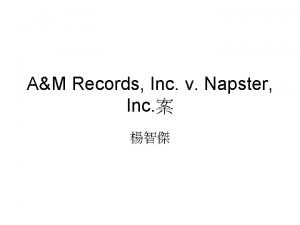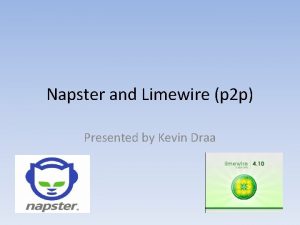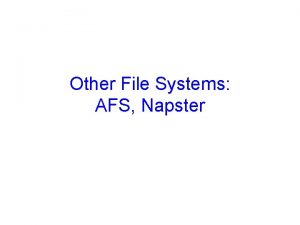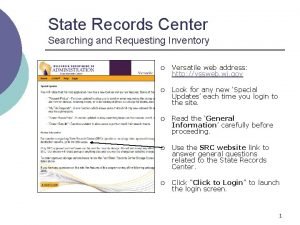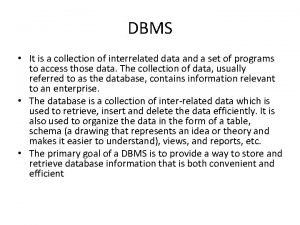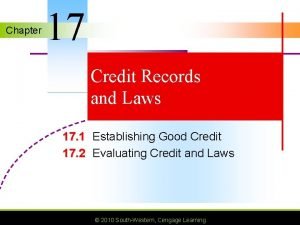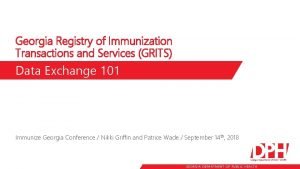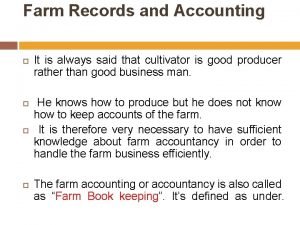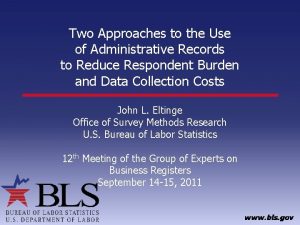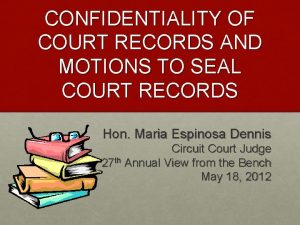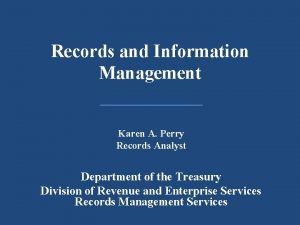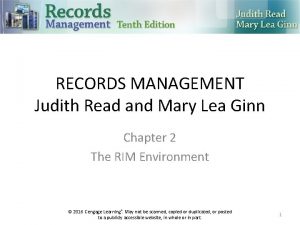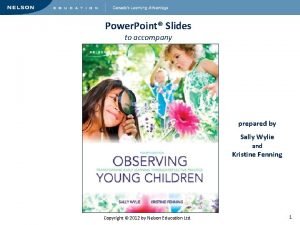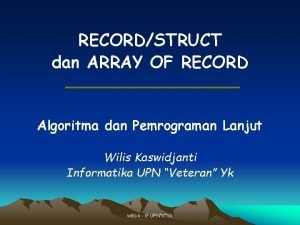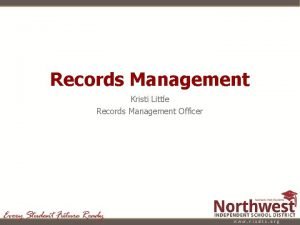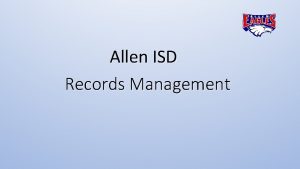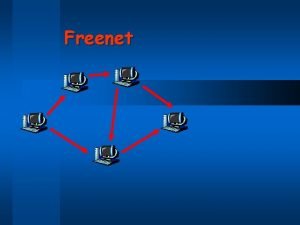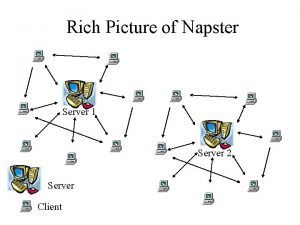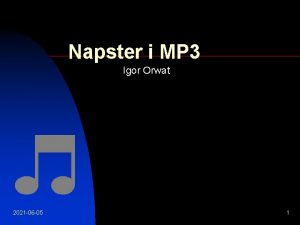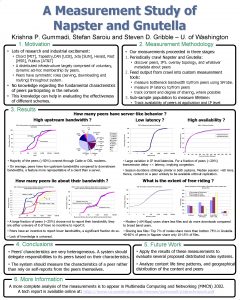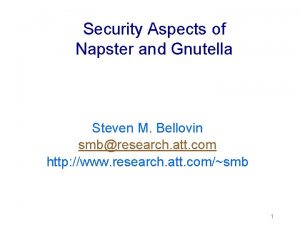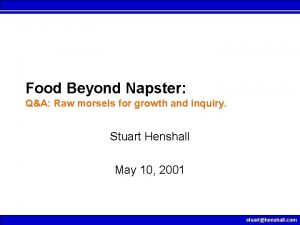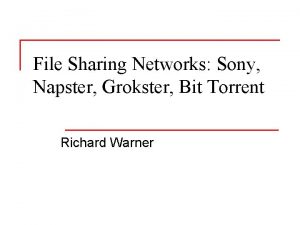AM Records Inc v Napster Inc AM Records






















- Slides: 22

A&M Records, Inc. v. Napster, Inc. 案 楊智傑

第一個代表案例 • A&M Records, Inc. v. Napster, Inc. , 239 F. 3 d 1004 (2001) was a landmark(指標) intellectual property(智慧財產權) case in which the United States Court of Appeals for the Ninth Circuit(第九巡迴上訴法院) affirmed the ruling of the United States District Court for the Northern District of California(加州南區地區法 院), holding that defendant, peer-to-peer (P 2 P) file-sharing service Napster, could be held liable for contributory infringement(輔助侵權) and vicarious infringement(代位侵權) of the plaintiffs' copyrights.

被告Napster • Napster provided a platform for users to access and download compressed(壓縮) digital music files, specifically MP 3 s, from other users‘ machines. Unlike many peer-to-peer services, however, Napster included a central server(中 央伺服器) that indexed connected users and files available on their machines, creating a searchable list of music available across Napster's network.

原告 • The full list of plaintiffs included a number of record companies, all members of the Recording Industry Association of America (RIAA). • Universal Music Group, Sony Music Entertainment, EMI, and Warner Music Group are known as the "big four" in the music industry.

程序背景一 • Plaintiffs alleged both contributory(輔助 的) and vicarious(代位的) copyright( 著作權) infringement(侵權) by Napster, and soon filed a motion for a preliminary injunction(初步禁制令) in order to stop the exchange of plaintiffs' songs on the service immediately.

程序背景二 • Judge Marilyn Hall Patel of the United States District Court for the Northern District of California granted the preliminary injunction(初步禁制令), on the grounds that the plaintiffs demonstrated(論證了) a reasonable likelihood of success(勝訴之可能性). • Napster appealed to United States Court of Appeals for the Ninth Circuit.

直接侵權 • The Circuit Court agreed with the district court‘s threshold determination that Napster users were probably engaging in direct infringement(直接侵權) of plaintiffs' copyrights.

合理使用判斷一:使用之目的及性 質 • downloading an MP 3 is not transformative (轉化性) under the purpose and character of use factor, and that even though Napster didn‘t directly benefit financially from users’ downloads (i. e. , charge for the service), “repeated and exploitative(利用的) copying of copyrighted works, even if the copies are not offered for sale” could be considered a commercial use(商業性使用).

合理使用判斷二:被利用著作之性 質 • creative works(創造性作品), such as the songs in question, are “closer to the core” of intended copyright protection than non-creative works, thus favoring(有利於) the plaintiffs on the second factor(第二項 因素).

合理使用判斷三:使用之質量及所 佔之比例 • 3. They considered the potential that in some cases, wholesale(整批、全部) copying of a work may be protected, noting time-shifting(時間轉移) as an example.

合理使用判斷四:對著作價值現在 及潛在銷售市場之影響 • 4. widespread wholesale transfer of plaintiff‘s music negatively affected the market for CD sales and that it also jeopardizes(危及) the record industry’s future in digital markets.

試聽(sampling)非合理使用 • 1. sampling, where users make temporary(暫時 性) copies of a work to sample it before purchase, which the District Court found to be a commercial use even if a user purchases the work at a later time. • Sampling was deemed to not be a fair use, because the “samples” were in fact permanent( 永恆的) and complete(完全) copies(重製品) of the desired media.

空間轉移(space-shifting) • space-shifting(空間轉移) of musical compositions and sound recordings is a fair use. See Recording Indus. Ass'n of Am. v. Diamond Multimedia Sys. , Inc. , 180 F. 3 d 1072, 1079 (9 th Cir. 1999)

時間移轉(time-shifting) • Sony, 464 U. S. at 423 (holding that “timeshifting, ”(時間轉移) where a video tape recorder owner records a television show for later viewing, is a fair use). • Both Diamond and Sony are inapposite because the methods of shifting in these cases did not also simultaneously involve distribution(散布) of the copyrighted material to the general public.

輔助侵權( contributory infringement ) • In order to prove contributory infringement, a plaintiff must show that a defendant had knowledge(知情) of infringement (here, that Napster knew that its users were distributing copyrighted content without permission across its network) and that defendant supplied material support(提供實質幫助) to that infringement.

知情( Knowledge) • The District Court ruled that the “law does not require knowledge of ‘specific acts of infringement‘ ” and rejected Napster’s assertion that, because they could not distinguish between infringing(侵權) and non-infringing(非侵權) files, they did not have knowledge of copyright infringement. • The Ninth Circuit upheld this analysis, accepting that Napster had “knowledge, both actual(實際 知情) and constructive(推定知情), of direct infringement. "

實質非侵權用途 • Sony Corp. of America v. Universal City Studios, Inc. , "the Betamax case“ • if a defendant “made and sold equipment capable of both infringing and substantial noninfringing uses(實質非侵權用途), " that fact alone—i. e. , "evidence that such machines could be and were used to infringe plaintiffs' copyrighted television shows" – would not be sufficient grounds to impute constructive knowledge to defendants.

知道有侵權素材卻不處理 • if a computer system operator learns of specific infringing material available on his system and fails to purge(淨化) such material from the system, the operator knows of and contributes to direct infringement. . Conversely, absent any specific information which identifies infringing activity, a computer system operator cannot be liable for contributory infringement merely because the structure of the system allows for the exchange of copyrighted material.

實質貢獻( Material contribution ) • The Ninth Circuit briefly approved the district court's analysis of this element.

代位侵權 • Addressing the vicarious infringement claim, the court then considered the necessary factors: – whether Napster benefited financially(財政上 得利) from the infringement and – whether they were capable of(有能力) supervising(監督) and controlling(控制) infringing conduct.

是否營利 • The Ninth Circuit sided with the District Court, who held that the infringing activity was a draw to potential users and that, since and Napster‘s future business model was predicated(取決於、基於) on expanding the number of users, Napster stood to benefit financially from the infringing activity.

有能力監督 • Napster had “the right and ability to supervise its users‘ conduct. “ • Napster’s ability to patrol(巡邏、偵查) and enforce infringing use was limited by the design of the system itself. The system was not designed to read the contents of MP 3 s or check for copyright ownership or permissions, only to index by name and ensure they are valid MP 3 files. • these indices and infringing files were just as searchable by Napster as they were by the plaintiffs in locating infringing files for evidence in the case.
 A&m records v. napster
A&m records v. napster Limewire history
Limewire history Napster and gnutella
Napster and gnutella Napster in distributed system
Napster in distributed system Napster software
Napster software Napster directory
Napster directory Versatile records
Versatile records A collection of interrelated records is called a
A collection of interrelated records is called a Chapter 17 records
Chapter 17 records Sumerian achievements
Sumerian achievements Summative scale
Summative scale Are medical records legal documents
Are medical records legal documents An instrument that constantly records ground movements.
An instrument that constantly records ground movements. Grits ga immunization
Grits ga immunization Difference between single and double entry system
Difference between single and double entry system Administrative records
Administrative records Motion to determine confidentiality of court records
Motion to determine confidentiality of court records Artemis records retention
Artemis records retention Records management mary l. ginn
Records management mary l. ginn Disadvantages of running records
Disadvantages of running records Mrp processing
Mrp processing Kyir vaccine
Kyir vaccine Algoritma records
Algoritma records
